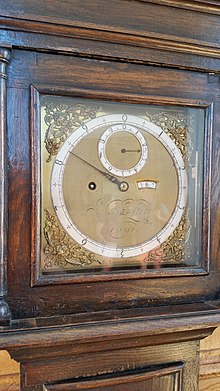One of the two known surviving sidereal angle clocks in the world. It was made for Sir George Shuckburgh-Evelyn. It is on display in the Royal Observatory, Greenwich, London.
This astronomical clock uses dials showing both sidereal and solar time.
Sidereal time /saɪˈdɪəriəl/ is a timekeeping system that astronomers use to locate celestial objects. Using sidereal time, it is possible to easily point a telescope to the proper coordinates in the night sky. Briefly, sidereal time is a "time scale that is based on Earth's rate of rotation measured relative to the fixed stars".
Photo of the face of one of the two Sidereal Angle clocks in the Royal Observatory in Greenwich, England.
Viewed from the same location,
a star seen at one position in the sky will be seen at the same
position on another night at the same sidereal time. This is similar to
how the time kept by a sundial can be used to find the location of the Sun. Just as the Sun and Moon appear to rise in the east and set in the west due to the rotation of Earth, so do the stars. Both solar time
and sidereal time make use of the regularity of Earth's rotation about
its polar axis, solar time following the Sun while sidereal time roughly
follows the stars.
More exactly, sidereal time is the angle, measured along the celestial equator, from the observer's meridian to the great circle that passes through the March equinox and both celestial poles, and is usually expressed in hours, minutes, and seconds.
Common time on a typical clock measures a slightly longer cycle,
accounting not only for Earth's axial rotation but also for Earth's
orbit around the Sun.
A sidereal day is approximately 23 hours, 56 minutes, 4.0905 SI seconds (24 hours - 4 minutes + 4 seconds = 86164.0905 s = 23.9344696 h). The March equinox itself precesses
slowly westward relative to the fixed stars, completing one revolution
in about 26,000 years, so the misnamed sidereal day ("sidereal" is
derived from the Latin sidus meaning "star") is 0.0084 seconds shorter than the stellar day, Earth's period of rotation relative to the fixed stars.
The slightly longer "true" sidereal period is measured as the Earth Rotation Angle (ERA), formerly the stellar angle. An increase of 360° in the ERA is a full rotation of the Earth.
Because Earth orbits the Sun once a year, the sidereal time at
any given place and time will gain about four minutes against local civil time,
every 24 hours, until, after a year has passed, one additional sidereal
"day" has elapsed compared to the number of solar days that have gone
by.
Comparison to solar time

Sidereal time vs solar time. Above left: a distant star (the small orange star) and the Sun are at culmination, on the local meridian m. Centre: only the distant star is at culmination (a mean sidereal day). Right: a few minutes later the Sun is on the local meridian again. A solar day is complete.
Solar time is measured by the apparent diurnal motion
of the Sun, and local noon in apparent solar time is the moment when
the Sun is exactly due south or north (depending on the observer's
latitude and the season). A mean solar day (what we normally measure as a
"day") is the average time between local solar noons ("average" since
this varies slightly over the year).
Earth makes one rotation around its axis in a sidereal day;
during that time it moves a short distance (about 1°) along its orbit
around the Sun. So after a sidereal day has passed, Earth still needs to
rotate slightly more before the Sun reaches local noon according to
solar time. A mean solar day is, therefore, nearly 4 minutes longer than
a sidereal day.
The stars are so far away that Earth's movement along its orbit
makes nearly no difference to their apparent direction (see, however, parallax), and so they return to their highest point in a sidereal day.
Another way to see this difference is to notice that, relative to
the stars, the Sun appears to move around Earth once per year.
Therefore, there is one fewer solar day per year than there are sidereal days. This makes a sidereal day approximately 365.24366.24 times the length of the 24-hour solar day, giving approximately 23 h 56 min 4.1 s (86,164.1 s).
Precession effects
Earth's
rotation is not a simple rotation around an axis that would always
remain parallel to itself. Earth's rotational axis itself rotates about a
second axis, orthogonal to Earth's orbit, taking about 25,800 years to perform a complete rotation. This phenomenon is called the precession of the equinoxes.
Because of this precession, the stars appear to move around Earth in a
manner more complicated than a simple constant rotation.
For this reason, to simplify the description of Earth's orientation in astronomy and geodesy, it was conventional to chart the positions of the stars in the sky according to right ascension and declination,
which are based on a frame that follows Earth's precession, and to keep
track of Earth's rotation, through sidereal time, relative to this
frame as well.
In this reference frame, Earth's rotation is close to constant, but the
stars appear to rotate slowly with a period of about 25,800 years. It
is also in this reference frame that the tropical year,
the year related to Earth's seasons, represents one orbit of Earth
around the Sun. The precise definition of a sidereal day is the time
taken for one rotation of Earth in this precessing reference frame.
Modern definitions
In the past, time was measured by observing stars with instruments such as photographic zenith tubes and Danjon astrolabes, and the passage of stars across defined lines would be timed with the observatory clock. Then, using the right ascension
of the stars from a star catalog, the time when the star should have
passed through the meridian of the observatory was computed, and a
correction to the time kept by the observatory clock was computed.
Sidereal time was defined such that the March equinox would transit the meridian of the observatory at 0 hours local sidereal time.
Beginning in the 1970s the radio astronomy methods Very Long Baseline Interferometry (VLBI) and pulsar timing overtook optical instruments for the most precise astrometry. This led to the determination of UT1
(mean solar time at 0° longitude) using VLBI, a new measure of the
rotation of the Earth named Earth Rotation Angle, and new definitions of
sidereal time. These changes were put into practice on 1 January 2003.
Earth Rotation Angle
The
Earth Rotation Angle (ERA) measures the rotation of the Earth from an
origin on the celestial equator, the Celestial Intermediate Origin, that
has no instantaneous motion along the equator; it was originally
referred to as the non-rotating origin. ERA replaces Greenwich Apparent
Sidereal Time (GAST). The origin on the celestial equator for GAST,
called the true equinox,
does move, due to the movement of the equator and the ecliptic. The
lack of motion of the origin of ERA is considered a significant
advantage.
ERA, measured in radians, is related to UT1 by the expression
where tU is the Julian UT1 date − 2451545.0.
The ERA may be converted to other units; for example, the Astronomical Almanac for the Year 2017 tabulated it in degrees, minutes, and seconds.
As an example, the Astronomical Almanac for the Year 2017 gave the ERA at 0 h 1 January 2017 UT1 as 100° 37′ 12.4365″.
Sidereal time
Although
ERA is intended to replace sidereal time, there is a need to maintain
definitions for sidereal time during the transition, and when working
with older data and documents.
Similarly to mean solar time, every location on Earth has its own
local sidereal time (LST), depending on the longitude of the point.
Since it is not feasible to publish tables for every longitude,
astronomical tables make use of Greenwich sidereal time (GST), which is
sidereal time on the IERS Reference Meridian,
less precisely called the Greenwich, or prime meridian. There are two
varieties, mean sidereal time if the mean equator and equinox of date
are used, or apparent sidereal time if the apparent equator and equinox
of date are used. The former ignores the effect of nutation
while the latter includes nutation. When the choice of location is
combined with the choice of including nutation or not, the acronyms
GMST, LMST, GAST, and LAST result.
The following relationships hold:
- local mean sidereal time = GMST + east longitude
- local apparent sidereal time = GAST + east longitude
The new definitions of Greenwich mean and apparent sidereal time (since 2003, see above) are:
where θ is the Earth Rotation Angle, EPREC is the accumulated precession, and E0 is equation of the origins, which represents accumulated precession and nutation. The calculation of precession and nutation was described in Chapter 6 of Urban & Seidelmann.
As an example, the Astronomical Almanac for the Year 2017
gave the ERA at 0 h 1 January 2017 UT1 as 100° 37′ 12.4365″. The GAST
was 6 h 43 m 20.7109 s. For GMST the hour and minute were the same but
the second was 21.1060.
Relationship between solar time and sidereal time intervals
If a certain interval I
is measured in both mean solar time (UT1) and sidereal time, the
numerical value will be greater in sidereal time than in UT1, because
sidereal days are shorter than UT1 days. The ratio is:
where t represents the number of Julian centuries elapsed since noon 1 January 2000 Terrestrial Time.
Sidereal days compared to solar days on other planets
Of the eight solar planets, all but Venus and Uranus have prograde
rotation—that is, they rotate more than once per year in the same
direction as they orbit the Sun, so the Sun rises in the east. Venus and Uranus, however, have retrograde rotation. For prograde rotation, the formula relating the lengths of the sidereal and solar days is:
- number of sidereal days per orbital period = 1 + number of solar days per orbital period
or, equivalently:
- length of solar day = length of sidereal day/1 − length of sidereal day/orbital period.
On the other hand, the formula in the case of retrograde rotation is:
- number of sidereal days per orbital period = −1 + number of solar days per orbital period
or, equivalently:
- length of solar day = length of sidereal day/1 + length of sidereal day/orbital period.
All the solar planets more distant from the Sun than Earth are
similar to Earth in that, since they experience many rotations per
revolution around the Sun, there is only a small difference between the
length of the sidereal day and that of the solar day – the ratio of the
former to the latter never being less than Earth's ratio of 0.997. But
the situation is quite different for Mercury
and Venus. Mercury's sidereal day is about two-thirds of its orbital
period, so by the prograde formula its solar day lasts for two
revolutions around the Sun – three times as long as its sidereal day.
Venus rotates retrograde with a sidereal day lasting about 243.0 Earth
days, or about 1.08 times its orbital period of 224.7 Earth days; hence
by the retrograde formula its solar day is about 116.8 Earth days, and
it has about 1.9 solar days per orbital period.
By convention, rotation periods of planets are given in sidereal terms unless otherwise specified.




